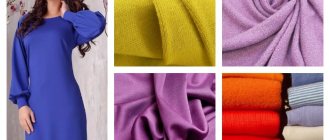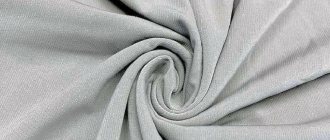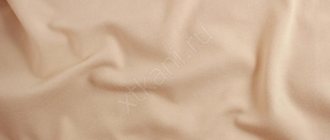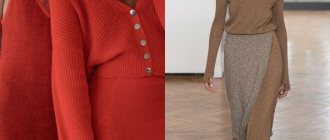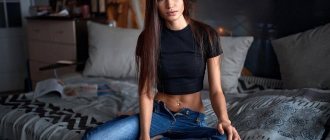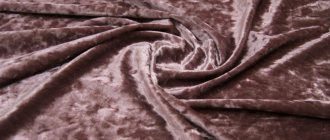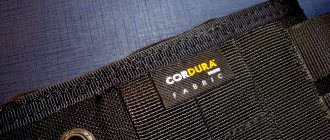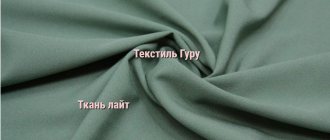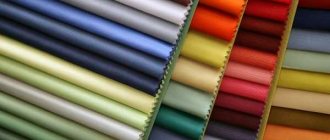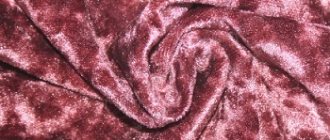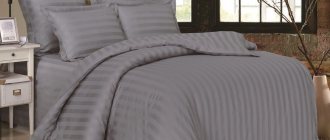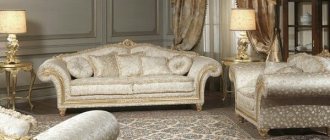On European territory, the fashion for elastic and soft fabric came in the 15th century, when knitting machines were designed. The start of mass production brought knitwear into use not only among peasants and artisans, but also among aristocrats. Already in the 20th century, Italian fashion designers raised clothing to the pinnacle of popularity, where it confidently holds its position.
Knitwear is
An elastic fabric that is not woven, but knitted. Therefore, the phrase “knitted fabric” is not entirely correct; it is better to say “knitted fabric”. During the production of knitwear, the yarn or threads bent during the knitting process have a complex spatial arrangement. The word “knitwear” itself is borrowed from the French language: tricotage from tricoter - to knit. Indeed, if you look closely at the texture of the fabric, you will notice a knitted structure created using the loop method on a special knitting machine.
Fun fact: “knitwear” and “jersey” are the same thing. It’s just that in the countries of Western Europe and the American continent the name “jersey” is accepted, which when translated into Russian means “knitted fabric of a smooth weave (knitted).” But both words are used with equal frequency. Moreover, they are often perceived not as synonyms and even begin to be endowed with different properties.
It is difficult to say exactly when and under what conditions knitwear or the first knitted product appeared. It can certainly be said that people created knitted items even before our era. It’s interesting that at first everything was done by hand—literally knitted with fingers. Then, with the invention of knitting needles and crochet, knitting improved and became a separate profession. At the same time, finely handmade knitted items, for example, high-quality stockings made from silk yarn, could be very expensive - only wealthy people could afford them. Of course, this did not apply to simple knitted items made from coarse yarn.
The first loom for knitting knitwear was invented in 1589. The inventor of this mechanism was William Lee, an assistant parish priest from England. The inspiration for the loom came from Lee's wife, who knitted for a living. He wanted to help her automate this process, thereby making her backbreaking work easier. An experienced knitter performed about 100 stitches per minute, and the new machine could increase the speed to 600. There is a legend that Queen Elizabeth I herself visited the inventor to study his creation. Unfortunately, she did not like the machine; the products created from coarse wool seemed too dense and not as high quality as they could have been as a result of hand knitting. Even after finalizing the technical nuances, William Lee did not receive a patent from the Queen. Some justify this act by Elizabeth’s reluctance to deprive knitters of their income. This attitude forced the priest to move from England to France, where he was able to successfully develop his own business. His machines spread quickly throughout Europe.
Tights
To make this type of knitted weave, one thread is used. During the knitting process, the loops are placed sequentially in two adjacent stitches. Each loop of the fabric has a broach located at an angle to it.
Unlike the satin weave, the knitted fabric made using the tights technique has two identical sides, both the front and the back. Some types of this technique make it possible to obtain a canvas in the form of a mesh. In such knitwear, the edges of the cells are loops and broaches located on opposite sides.
When stretching the fabric lengthwise, the loop columns will become deformed - they will connect.
You can unravel the tights only in the opposite direction of knitting. This is typical for all types of warp weave.
The knitted fabric of the leotard unfolds along the line of the loop column. As a result, the product is divided into two parts. This can be checked by cutting out a rectangle, clearing the edges of the cut threads and pulling the piece of knitwear wide. It is for this reason that in the process of cutting out finished products you should not remove cut threads from the edge of the fabric. This way you can avoid unraveling of the knitwear. In order for the finished fabric to be removed from the knitting machine without unraveling, it must be cut along the loop row and the remaining threads saved.
The fabric made from artificial silk is most susceptible to unraveling. Since the coefficient of friction of this yarn is low, several times less than that of cotton thread.
The advantage of tights is the fact that the finished fabric does not curl at the edges. This greatly simplifies the process of further cutting products.
When did knitwear come into fashion?
It is impossible to talk about the role of knitwear in the world of haute couture without mentioning two talented women - Coco Chanel and Elsa Schiaparelli. Already in the late 1920s, knitted sweaters were shining on the catwalk in Schiaparelli's collection. For the beginning of the 20th century, this was an unusual and bold discovery. There is a version that Elsa first saw a similar sweater on her friend, and he, in turn, said that it was knitted by an emigrant from Armenia. Coco Chanel, in turn, gave the history of fashion machine-made knitwear - jersey. Before her, this fabric was used mainly for sewing men's underwear. The Frenchwoman dared to create elegant clothes for ladies of the privileged class from jersey. An unimaginably daring decision!
The main manufacturers of knitwear in TISSOURA: Marioboselli Jersey (Italy), Guigou (France), Hausammann (Switzerland), Binda (Italy), Carnet (Italy).
What's in knitwear?
Knitted fabric can be made from yarn of a wide variety of origins. The composition varies depending on the purpose and functionality of the canvas. Knitwear made from natural fibers is especially valued. The raw materials used are silk, linen, cotton, wool and various synthetic materials in the form of additives. They can vary in type of twist and length. Most often, combined options are used, which combine natural and synthetic materials.
Elastane is often added to knitted fabrics to increase elasticity and the ability to retain shape. Combined knitwear usually combines the best properties of natural and synthetic materials. For example, pure cotton wears out and wrinkles a lot, does not fit well, and synthetic fabrics are electrified and can cause allergies. When producing mixed, that is, combined fabrics, manufacturers achieve a harmonious combination of the best characteristics of each type of raw material.
Any time for everyone
Today our market offers knitwear from Russia, Turkey, Poland, China... A wide variety of Belarusian items.
Our knitwear is also in demand abroad - in the CIS countries and the EU. — Belarusian models meet the needs of a wide range of buyers, —
comments Ekaterina Kalenyuk.
— It has long been known that clothing designers are guided by the characteristic features of the people around them. The Chinese sew small things, they simply cannot maintain proportionality for large people. Europeans will never get out of the habit of dressing people according to model, almost unrealistic standards and templates. Belarusian knitwear is suitable for men and women from anywhere in the world - a petite Chinese woman will find a loose or tight turtleneck for herself, Slavic women will choose things for their strong, well-shaped figure, and Western European or American models will be able to demonstrate their grace in our products. Another distinctive feature of Belarusian knitwear can be called density. It is thanks to her that things practically do not wear out.
Types of knitwear
Knitted fabrics differ according to several criteria: density, composition, additional materials, design, texture and structure. We will tell you more about the types of knitwear below.
Depending on the method of combining weaves of different classes in knitwear, knitwear is distinguished into simple, derivative-combined, patterned and complex combined weaves. In addition to class, weave can be characterized by rapport. Knitwear is also characterized by stretchability, strength, unraveling (both in the direction of knitting and against it), edge curl, and surface density.
Manufacturing methods
The main elementary link in the structure of a knitted fabric is a loop, consisting of a core and a connecting broach. Loops located horizontally form loop rows, and loops located vertically form loop columns. The terms “lobe” and “weft” are not for knitted fabric.
- Weaving options
Cross-knitted knitwear is formed from one thread using one system of threads; Knitted loops are straight and can open vertically and horizontally. This knitwear is elastic in the transverse direction and retains its shape well.
Warp knitwear is formed from all the warp threads, each loop is knitted with its own thread. Warp knitted fabric has slanted loops, does not unravel horizontally, and has very little unraveling vertically.
- Knitwear finishing options
Finishing of knitwear mainly consists of the same operations as finishing of fabrics - bleaching, stabilization (for knitwear made from synthetic threads), dyeing or printing, napping (for some types of knitwear) and final finishing.
Structure and weave
Clothes for the little ones can also be made of knitwear.
Based on the structure of the weave, there are two large types of knitwear: cross-knitted (knitted) and warp-knitted. Any type of knitwear is created from two systems of threads - a horizontal weft and a vertical warp.
Cross-knitted (knitted) knitwear is made as follows: loops of one row are formed by a sequential connection of one or more threads. The loops are connected one after another according to a certain alternation of thread systems. Weaving occurs in the direction of the loop row. To form, for example, a cross weave, the threads are moved to the right side, shifting them under the needles of the knitting machine - the fabric will not be either vertical or horizontal.
To create matter, one fiber is used, which is made using one thread system - straight loops appear. Thanks to this feature, the fabric can be unraveled in any direction, it turns out to be very elastic. Let's look at several types of cross-knitted knitwear.
- Double-sided ("reverse knit") - looks like the reverse side of the satin stitch. Women's head scarves and elastic headbands are made from this material.
- Interlock – combined knitwear. The characteristic pattern of interlock is called elastic. Thanks to the peculiarities of weaving, the interlock does not unravel, lasts a very long time and looks decent in appearance. The basis of the material is natural cotton. Synthetic elastane is used as an additive. Material density 220-330 g/m². Interlock is used to make underwear, soft pajamas and T-shirts.
- An eraser (ribana) is an elastic fabric. The material is produced in the form of a compact strip, the finished products are of medium thickness. Products made from eraser are very dimensional stable. Material density – 170-350 g/m². Turtlenecks, jumpers, and cuffs are made from eraser. The material does not wrinkle at all.
- Satin stitch (coulir) refers to a weave in which the differences between the back and front sides are obvious. The reverse is formed by arcs, it is rough to the touch, and the front consists of sticks, its texture is smooth. The finished fabric is thin, there is no fleece. To get a horizontal row, the threads go around sequentially - the fabric stretches better in width than in length. This material is used to create robes, underwear and light clothing for the summer. The base consists of cotton threads, and the additive is lycra. Synthetics are added to increase elasticity and firmness. The result is a fabric with a density of 145-180 g/m² (the exact figure depends on the characteristics of production, raw materials and the specified modes on the knitting machine).
Warp knitwear is formed by individual threads or their entire systems, that is, warps. Each base forms several loops. To create a loop row, you need to use as many threads as there are loops in the row. Let's take a closer look at the varieties of warp knitting.
- Satin - threads create loops in each of the columns of the fabric. The shift can be made in both directions during weaving. Thanks to this position, a zigzag type pattern is obtained. To make satin, silk, mainly artificial (viscose or synthetic), or cotton is used. Flax fibers can be used as a supplement. The properties of such fabric are determined by the composition and its ratio. Curtains, bedding sets and underwear are made from satin knitwear.
- Tricot - during knitting, the threads are shifted one row to one side. When the loop is tied to the end, the structure returns to its original position. Columns are created from two threads located next to each other.
- Cloth - when knitting, threads are placed on needles, which are not located next to each other, but in the direction of one side. The main feature of weaving is that the reverse side acts as the front side, because due to the specifics of production, the face looks less aesthetically pleasing. Cloth is used in the production of underwear.
- Chain - consists of loops made in a vertical row. Loops are made on each needle from one thread. The chain is used to make decorative fringe for finishing the edges of the fabric.
There are also two types of weaving that have significant visual differences:
- single - front threads are on one side, and purl threads are on the other;
- double - both sides are considered front, and to produce such weaving you need special round hosiery machines with two cylinders.
In addition to the above, there are also the following weaving options:
- Combined - divided into two varieties (jacquard and pressed).
- Patterned - this type of weave is connected in rows with various loop elements. This is one of the most difficult weaves.
- Derivative - loop columns of the simplest weaves are combined. To create a fabric, two threads are placed under the hook at once, which are connected at different angles.
- Main. To create this type of weave, only one loop is used. This method is used to create an eraser and smooth surface.
Pressed combined weaving is used as a substitute for openwork (smooth patterned material). Its production requires machines with one or two cylinders. Not all threads are put to work and some are skipped. Even though they are not used, these threads serve to support the workers. “Throws” of this kind are connected into a loop with the main thread, which results in a pressed fabric.
A distinctive feature of jacquard weave is the creation of complex patterns. This is a labor-intensive process that involves a large number of needles. For complex combinations, additional processing procedures are applied. These include fixing several threads in a loop during weaving, and so on. Jacquard weaving is used for zigzag knitting and creating openwork.
Types of knitted fabrics
Footer
The homeland of footer is India, and it was there that they learned how to make this cotton knitwear. Soft fabric with fleecy fleecy on one side. Durable and warm knitted fabric.
Kulirka, or kulirka surface.
A cross-knitted knitted fabric, on the front side there is weaving in the form of longitudinal braids, and on the back side the pattern resembles very fine brickwork. It stretches very well in width and practically does not stretch in length. Used for the manufacture of linen products and summer clothes. The terms “pene”, “carde”, “ring”, “open end” are related to cotton stockinette and are associated with the length of the fibers from which the threads are twisted. “Penya” are the longest, “oppened” are the shortest.
Jersey
Same as knitwear.
Pique
It is distinguished by a complex weave, thanks to which a fine pattern is formed on the surface. Tissura's assortment consists mainly of pique cotton from the Italian manufacturer Carnet. Designs – colorful prints in the form of flowers. Initially, this lightweight knitwear was used to sew polo shirts.
Selanik
Soft, rather dense fabric with a delicate texture. On the wrong side there is a fluffy bouffant.
Lacoste
It is distinguished by a loose, homogeneous structure reminiscent of a honeycomb.
Interlock
Soft, comfortable double jersey. When making the fabric, two rows of knitting needles are used. Interlock knitwear is popular for the production of children's underwear, underwear, and homewear because it is very delicate and soft.
Dior
Knitwear made of synthetic fibers, characterized by a recognizable textured pattern in the form of diamonds on the surface of the fabric.
Biflex
The name literally translates as “stretching in two directions.” Indeed, due to the high lycra content, the knitted fabric stretches well in both the longitudinal and transverse directions.
Kashkorse
Knitted fabric knitted with English elastic. It is cash corse that is most often used to make cuffs, necklines, and belts.
Gipel
Typically knitwear is a loop fabric, but with gipel this is not the case. This fabric has additional weft threads that do not form loops, and the design is on the surface.
Capitonius
Multilayer fabric with insulation as an inner layer. On the outside there is a relief, but not very noticeable geometric pattern on the surface.
Otto (Ottoman)
Comfortable and practical fabric that does not stretch much, so it holds its shape well. Belongs to the category of costume materials.
Eraser
It is distinguished by a clear, easily recognizable vertical scar.
French knitwear
Initially, the name corresponded to the country of origin of this material, but gradually knitwear that was not produced in France began to be called this. Soft, elastic and comfortable fabric with a loose woven structure.
Oil or “cold” viscose fabric
Elastic knitwear, so named due to its pleasant sliding, “buttery” texture. Matter came to Europe straight from the East. The United Arab Emirates is considered the birthplace of the fabric. It is curious that in English the material is called slinky, that is, “tight-fitting”.
Ribana
Cross-knitted knitted fabric. As a result of alternating purl and knit stitches, a material is obtained that resembles a fine elastic band in texture.
Production Features
Knitwear products are practical and inexpensive.
There are several ways to produce the material.
- Cutting – used to create underwear, outerwear and gloves. First, a piece of fabric is made, and then the structural elements necessary for sewing clothes are cut out of it according to patterns. The parts are sewn together using a special machine. One of the features of this method is the large amount of waste, which in the manufacture of outerwear is approximately a quarter or a third. It is used only for inexpensive consumer products.
- Regular - expensive raw materials are used. The method is more suitable for small production. The process turns out to be economical, but also labor-intensive. The regular method involves knitting the whole product at once, and not its individual parts. Additional tying is allowed only for small parts that are fastened with small stitches. The finished product has no visible seams.
- Semi-regular – used mainly when creating outerwear. Knitwear is made on a circular knitting machine. The edge of the material is formed by a series of loops and does not require additional processing after manufacturing. The method is very economical both in terms of time and raw material consumption. There are no skips during sewing, which saves about 5% of material. In the semi-regular method, you do not have to waste time on cutting out parts, which helps save about another 4% of material.
Each category of fabric uses its own knitting machines.
- The knitting stitch is made on a circular knitting machine. A cylinder with a peripheral rotation speed of up to 0.7 is used. The maximum number of needles on the largest shaft can be about 13.5 thousand pieces.
- The footer weave is done on a single circular knitting machine. It has about a thousand needles and can form up to 8 knitting systems. Such a mechanism can produce 1800 rows of loops in one minute of operation at maximum speed. The knitting speed is adjusted depending on the required mode.
At the final stage of production, knitwear is given a presentable appearance. For this purpose, there are the following finishing methods:
- Variegated knitting is a type of processing that results in a multi-colored surface of the fabric by intertwining already dyed threads.
- Bleached – the material is lightened to a uniform white or light cream color. Bleaching is used as an independent type of treatment, as well as as a base for further coloring.
- Plain dyeing is a method of monochromatic color dyeing of the finished canvas.
- Unfinished (severe) - unfinished knitwear is obtained at the very first stage of fabric production. This is a material that does not undergo any additional finishing.
After processing, knitwear can be smooth or fluffy. To create pile on the surface, special needle tapes and cones are used - the parts are located on the shafts of pile machines.
Where is knitwear used?
Linen . Cotton knitwear is especially valued for creating underwear because it does not wrinkle, does not wear out quickly, and does not restrict movement! It is important that, thanks to natural fibers, this material is breathable and hygroscopic.
Shirts . The fabrics are slightly deformed and are produced mainly using charme-chain, cloth-tricot and other weaves. The plasticity and stretchability of the material makes products made from it as comfortable and easy to wear as possible.
Dresses, skirts. They are easy to wash, do not shrink much, and have low creasing.
Description
Knitwear is a finished product or knitted fabric, the production of which can be made from threads of the same type or different types, the weaving of which is carried out on special equipment. It is very difficult to distinguish knitted fabrics from each other from a photo, because the material may differ in composition, area of use, structure, and finishing.
Knitwear is made from natural wool, cotton, linen threads, as well as from synthetic or artificial materials (lycra, viscose, polyester, etc.).
Advantages and disadvantages of knitted fabric
The obvious advantages include:
- The loops take different shapes, so the fabric stretches perfectly in different directions.
- Has good breathability and regulates temperature.
- The products do not need ironing, because they do not wrinkle! It’s very convenient in the realities of a dynamic world, isn’t it?
- Knitwear does not restrict movement and fits nicely to the body.
- Not electrified.
Disadvantages noted by experts:
- Such a cozy and seemingly simple knitwear still has some drawbacks. Firstly, it stretches easily, so narrow products lose their shape quite quickly. Secondly, not everyone likes to wear tight clothes, so knitwear is not suitable for everyone.
- In addition, knitwear pills, so we recommend that you carefully monitor how your favorite clothes behave during wear.
- May stretch over time under improper storage conditions. Do not hang knitwear vertically. Store them folded.
Care Tips
You have already found out whether knitwear wrinkles or not. To prevent things from becoming deformed, you must follow simple care rules. Here's what you need to know:
- It must be washed by hand or in the “hand wash” mode;
- The maximum permissible washing temperature is 40 degrees;
- It is not recommended to use bleaching agents when washing;
- Do not squeeze or twist too much;
- When washing, you should not rub, but squeeze the item;
- The powder must be dissolved in water in advance, as its particles can leave marks on the product;
- Rinse in several waters;
- To make things soft, add fabric softener when rinsing;
- Drying knitwear in a centrifuge is not allowed;
- It is better to dry on a horizontal surface with a towel;
- It is not recommended to hang raw products in a vertical position. This way they can stretch;
- If pellets have formed on the surface, you can cut them off with a special machine or razor;
- Ironing is not recommended;
- If it seems to you that the product has become wrinkled, then the steam will return the item to its original form;
- It is not recommended to hang sweaters and dresses on hangers. They may become deformed;
- It is recommended to store in special bags, adding moth repellent and moisture-absorbing granules.
When we think of knitwear, soft, cozy sweaters, lightweight T-shirts, robes and underwear come to mind. This is a universal material, products from which can be found in every person’s wardrobe. With proper care, things will delight you with their comfort and warmth for a long time.
Types of knitwear in the video:
© 2021 textiletrend.ru
Rules for caring for knitwear
- Dry cleaning recommended. Cotton and viscose jersey can be washed if necessary. Hand washing is most optimal. Machine - only in delicate mode. Use a laundry bag. It is better to refuse the spin function.
- No hot water. This is a direct path to shrinkage or loss of shape of the product. The optimal temperature for washing and rinsing knitwear is 30-40 degrees.
- Don't rub. Otherwise, hated pellets will appear.
- Use only gentle detergents that do not contain alkalis, aggressive biological additives, bleaches, etc.
- Squeeze, not squeeze. Knitwear cannot be twisted. Just squeeze gently. You can also wrap the item in a towel.
- Dry horizontally, carefully straightening it out. Do not dry in direct sunlight. When heated, the cotton fibers are destroyed and the color fades.
- We recommend keeping knitwear items on a shelf, neatly folded.
Knitwear today is one of the most popular fabrics in the world. Knitwear is used to create fashionable jackets, skirts, trousers, coats and jackets.
Simplicity and minimalism
We figured out the composition.
What about the models? What knitwear items are popular this season? — Today, the trend is a voluminous silhouette. Sweaters, jumpers and turtlenecks of simple, laconic weaving with a minimum of patterns are especially relevant. This trend is driven by the fashion for meaningful consumption, the desire for closeness to nature, the desire for simplicity and minimalism,
—
Deputy Director for Development Inessa Gil
.
— The undisputed bestsellers are knitted accessories: hats and scarves.
Again, simple and concise, without unnecessary details or pretentiousness. One of the must-have items in your wardrobe this winter is a knitted dress. Straight midi dresses and voluminous ones in half-fang weave are popular.
- These models are definitely for the feast and for the world,
- assures the deputy director.
— For work you can combine it with a voluminous jacket of a men's cut, for walking - with a leather belt and sneakers.
Another must-have of the season is a knitted suit. In particular, voluminous and straight, cropped and classic knitted jumpers in combination with trousers - fitted and cuffed at the bottom, long and 7/8 length.
Wool knitwear
Wool knitwear is loved for its ability to give clothes a stylish and modern look, while maintaining warmth and comfort. Now, in order to add a fashionable cardigan or pullover to your wardrobe, you don’t need to spend long evenings knitting woolen patterns on knitting needles. Modern knitted fabrics are fabrics that are already decorated with intricate weaves of threads. All that remains is to choose a silhouette, buy knitted jersey at TISSUR and create a new fashionable item from this, as is done from ordinary fabrics.
Jersey fabric
Luxurious jersey fabrics are perfect for elegant dresses. By the way, the name of these knitted fabrics comes from the name of the island of Jersey, part of the Channel Islands archipelago. Initially, this fabric was associated only with underwear. But the great fashion rebel Coco Chanel “made jersey what we know it as today.”
The unique properties of knitted jersey fabric make it one of the most popular and beloved among our customers. Here are the main ones:
- Jersey practically does not wrinkle
- very soft and light. Even thick wool jersey fabrics look very “airy”
- the ability to create soft, beautiful folds when draping
- knitted jersey fabrics practically do not stretch in length, remaining very flexible in width
Cotton and linen knitwear
Charming T-shirts, sundresses and sweatshirts made from cotton or linen jersey will decorate your summer wardrobe. In the modern world of fashion, cotton jersey or elastic stretch cotton has become very relevant. Leading couturiers often use it in their collections. After all, it not only has excellent environmental qualities, but also looks great in finished products.
Knitwear knitted from linen threads has excellent bactericidal properties.
- Linen knitwear is hygroscopic and “breathes” perfectly.
- In summer, clothes made of linen jersey will always be cool, and warm in winter.
- And one more property of linen knitwear: it does not electrify.
Origin story
Previously, knitted clothing was considered rags for the poor and needy. It was only in the 20th century that this material was looked at from a different angle. Famous fashion designers began to use it to make suits. At first, knitted clothing became popular in England and France, then throughout Europe.
In the 20th century, two famous women, among them Elsa Schiaparelli, established the fabric's fame. Elsa saw her friend’s unusual sweater with an interesting knit. The product looked as if it had been sewn by an ordinary peasant woman, despite this the sweater was very soft and comfortable to the body.
The craftswoman was found quickly, she was invited to open the first knitwear workshop, and later the Schiaparelli fashion house. It was these fashion designers who made knitwear popular.
Knitwear in TISSURA fabric houses
In our fast-flying life, we value time very much. And in order not to lose it in search of fashionable knitted fabric, ideal for creating something that will decorate your wardrobe, come to TISSURA fabric salons and houses. Here you will be offered a huge selection of knitted fabrics: Italian knitwear from Agnona, Mario Boselli, Ruffo Coli, Luigi Verga, Lineaesse, French knitwear from Guigou, Swiss knitwear from Jakob Schlaepfer and Hausammann, which will delight you with original colors and modern prints.
Now, when purchasing fabric for a new outfit, you will probably turn your attention to designer knitwear - one of the most popular fabrics in the world.
